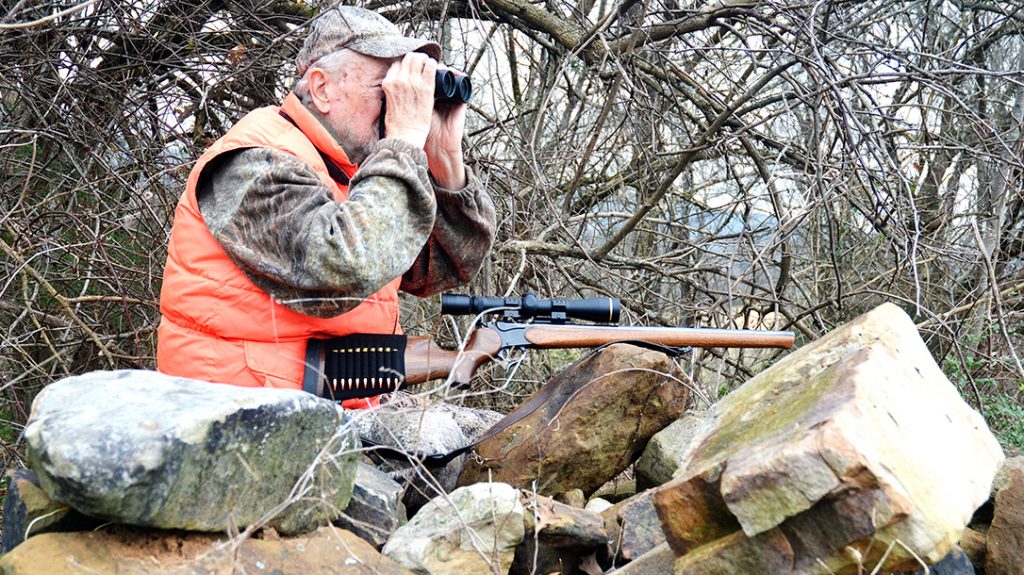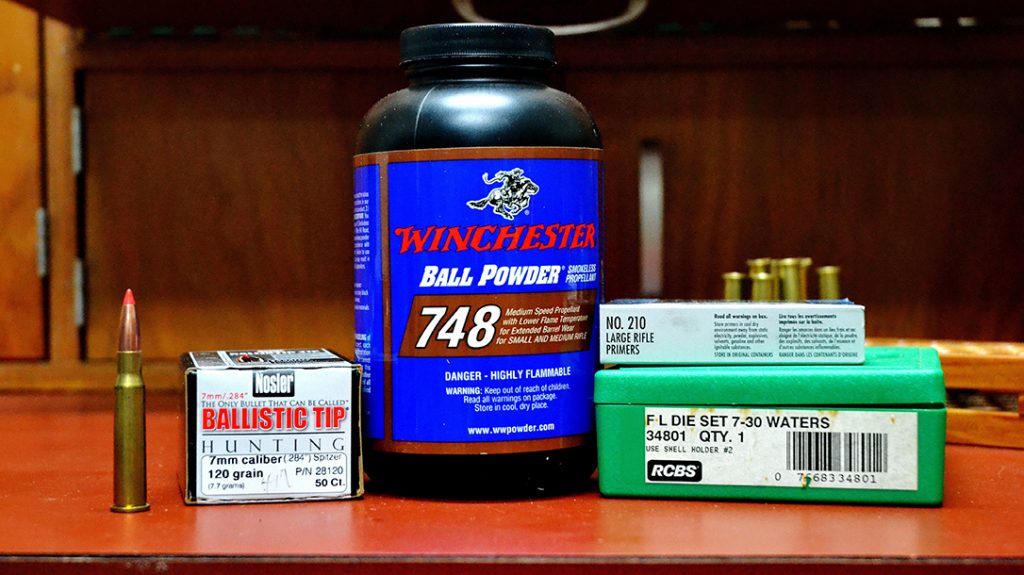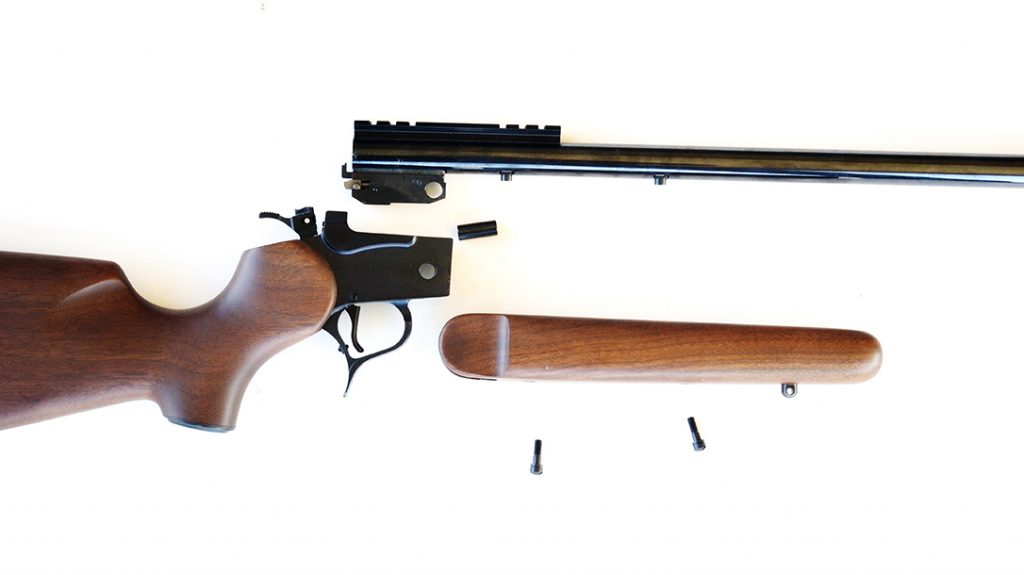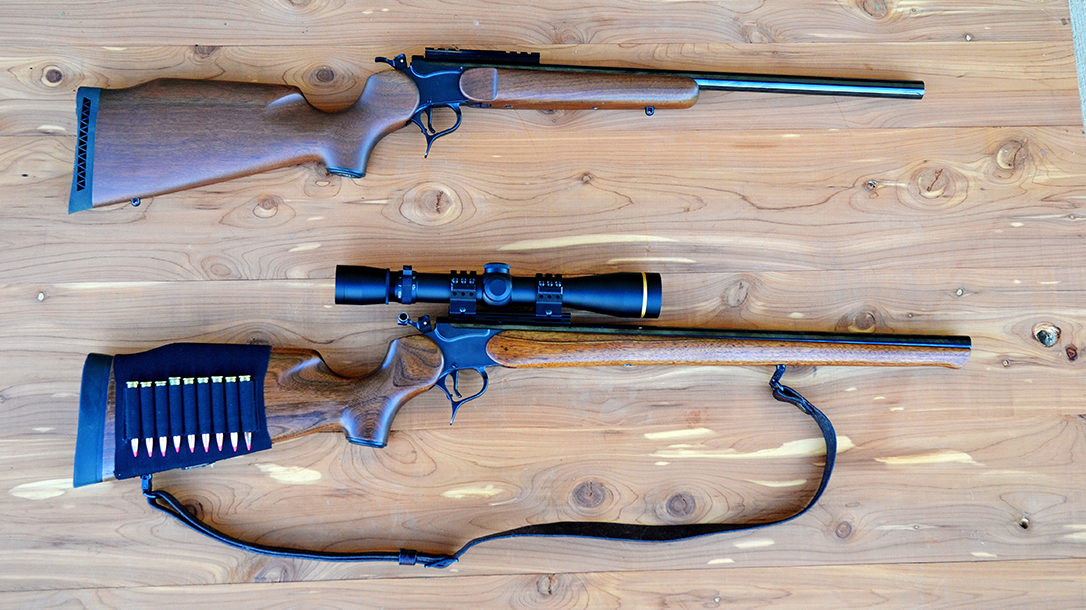It was the trek from hell. Getting into the mountainous fold of land so the wind would be in my favor required me to go straight up a bluff that was thick with cedar and limestone boulders. Then I had to slide down a steep hillside that was covered with scrub brush, greenbriers and rocks. I was soon in the rocky crevice that I used as a stand. It looked down into a large white-oak-covered basin where three deep hollows came together. Once settled in the rocks, I glanced down at the little Thompson/Center G2 Contender deer rifle I’d assembled just for hunting in these rough Cumberland Mountains. “So far so good,” I thought.
Within an hour, a large, 193-pound buck came to investigate the low grunts I’d made with my grunt tube, and the 7-30 Waters handload that I’d developed for this semi-custom rifle took the buck cleanly at just less than 200 yards. Following that first hunt, I named the rifle the Cumberland Deerslayer. Since then, the little rifle has taken many deer on the rugged Cumberland Plateau that spans parts of Kentucky, Tennessee, Alabama and Georgia.
It’d be incorrect to say that the Cumberland Deerslayer is a fully custom rifle. It’s a compact rifle I assembled to hunt a specific geographic region using aftermarket parts and a few friends. The resulting rifle is perfect for the area where I live and love to hunt. Any hunter can do the same for most geographical areas.
Advertisement — Continue Reading Below
What You Need for Your Deer Rifle
Taking an existing rifle and modifying it to meet your special geographic hunting conditions requires that you evaluate a couple of things. First, evaluate what your special conditions are. Then, evaluate what rifle requirements you need to meet those conditions. Perhaps you have a rifle that, with a few modifications, will do the job nicely. Here’s how I did it.

The Cumberland Mountains where I live and hunt are steep, rocky and extremely thick in many places, so I wanted a compact rifle with an overall length of about 35 inches. The mature bucks in this area spend most of their lives in the thick brush on the steep mountain slopes, in the crevices of rocky cliffs and among boulders as large as boxcars. It requires lots of steep hiking, so I wanted a lightweight rifle—nothing over 6.5 pounds including the scope.
Advertisement — Continue Reading Below
Due to the thick cover, getting a second shot is rarely an option. Since I’m a single-shot rifle fan, I knew that one of these would do the job. Plus, most single-shot rifles have short actions, reducing their overall length. I like to stalk hunt, so I wanted a well-balanced rifle for off-hand shooting and for long shots that would be easy to adjust on shooting sticks. Thus, I decided on a full-length Mannlicher-style stock. It helps that I just like the way a full-stock rifle looks.
Caliber Concerns
Most shots in this thickly vegetated, mountainous terrain are short—usually less than 100 yards. However, occasionally there’s a shot in open hardwoods or along a powerline right-of-way that may be out to 250 yards. So, I wanted a caliber that was proven at 100 yards while still being accurate and powerful out to 250 yards. Also, due to an ATV accident several years ago that shattered my right shoulder, leaving it recoil sensitive, I wanted a caliber with mild recoil.
So, my caliber criteria were relatively simple: I wanted a mild-recoil, mild-report cartridge that was easy to reload and would carry 1,000 foot-pounds of energy (fpe) out to 250 yards, the maximum range I would ever shoot the rifle. My desire for 1,000 fpe was logical, in my opinion; that’s the minimum energy it takes to put down a large rutting buck.
Advertisement — Continue Reading Below
The 7-30 Waters

I considered a number of popular deer calibers, but finally selected the 7-30 Waters, where a .30-30 case is necked down to 7mm. I had been handgun hunting a lot with Ken French, the late, great gun designer for Thompson/Center. Ken and I had been using Contender handguns in the 7-30 Waters caliber with great success out to 200 yards for deer and pronghorns. Being a 7mm caliber, there’s a wide selection of excellent bullets available. The 7-30 Waters is also easy to reload.
Ken and I began to study the ballistics of the 7-30 Waters when shot from a 21-inch rifle barrel. It resulted in what I was looking for: light recoil, low report and accurate with handloads out to 250 yards.
Advertisement — Continue Reading Below
There’s only one factory load available for the 7-30 Waters: Federal offers one that features a 120-grain Sierra GameKing BTSP bullet with a published muzzle velocity of 2,700 feet per second (fps) and 1,942 fpe at the muzzle. At 150 yards, the round has about 1,190 fpe; that’s plenty to bring down a big buck at that distance. However, at 250 yards, it’s down to only 825 fpe. With a 100-yard zero, the bullet strikes 5.1 inches low at 200 yards. But to get the terminal ballistics of a 7mm hunting bullet at 250 yards, reloading would be required.
The Deer Rifle Foundation
With a caliber selected, I started my search for the basic rifle from which to work. In my gun safe, I had a single-shot Thompson/Center G2 Contender rifle that had a 23-inch .223 Remington barrel. Since I had a lot of experience with the G2 Contender and liked it, I decided to remove that barrel and use the walnut-stocked receiver for the heart of the new rifle, as it had a crisp 5-pound trigger that I liked. The G2 Contender is easy to break down without gunsmithing skills, so I removed the .223 Remington barrel.
My next step was to order a 21-inch 7-30 Waters target barrel from the T/C Custom Shop without open sights. It was important that an anchor hole be drilled 8 inches from the muzzle for the upper sling swivel stud to go through the thin wood of the Mannlicher-style forearm. The guys at the custom shop said they could do it. (Sadly, while Thompson/Center no longer has a custom shop, excellent custom barrels for the G2 Contender are available from SSK Industries.)
Advertisement — Continue Reading Below

While waiting for the barrel, I designed a Mannlicher-style forearm for the barrel; it used the same attachment hardware for the .223 Remington setup. A friend and woodworker made the new forearm from walnut. Of course, I wanted the forearm to match the separate walnut stock. So after the forearm was complete, I had a local church woodworking group finish it to match the stock.
For one-shot rifle accuracy, and due to that shattered shoulder a few years ago, I wanted as little felt recoil as possible, so I installed a LimbSaver recoil pad on the stock. It reduces the felt recoil by up to 70 percent and helps control muzzle rise.
Advertisement — Continue Reading Below
All Together
The 7-30 Waters barrel arrived soon after I received the finished forearm, and I assembled the rifle immediately. It was a compact, lightweight beauty. Then I attached a Leupold 4.5-14x40mm VX-3 scope using a Weaver rail and rings. Since there wasn’t much room under the scope for my thumb to cock the G2 Contender hammer, I attached a Carlson’s hammer expander to make cocking the rifle easy. I also installed a leather sling, and for carrying extra cartridges, I added an Uncle Mike’s buttstock ammo holder.
On the range, the little rifle shoots 1.3-inch, five-shot groups on average at 100 yards with Federal factory loads. But my long-range hunting load for bucks at ranges out to 250 yards is a handload that I have come to trust with 120-grain Nosler Ballistic Tip bullets sitting on top of 35 grains of W748 powder. From the 21-inch barrel, the muzzle velocity is 2,487 fps, and at 250 yards, it still has 1,162 fpe. At 100 yards, this load gives me a three-shot group average of 0.87 inches using a sandbag rest. Shooting off of sticks, the gun will create a 1.1-inch, three-shot group at 200 yards. With a 200-yard zero, the bullet drop at 250 yards is only 4 inches. (Safety note: Since this load features a pointed bullet, it’s intended only for single-shot rifles. It would be unsafe to use in rifles with magazine tubes.)
Final Thoughts on Your Deer Rifle
The compact and lightweight Cumberland Deerslayer has served me well in the wild terrain where I hunt. It has also taken a number of bucks and a much larger number of does. I’ve found it to be an excellent wild hog rifle as well. So, if you have an area you like to hunt, make your dream a reality and assemble a special deer rifle for that area. You’ll take great pride in hunting with your own creation.
Advertisement — Continue Reading Below
























